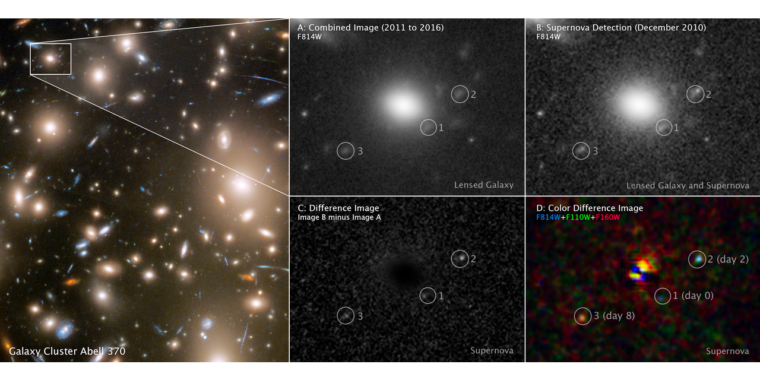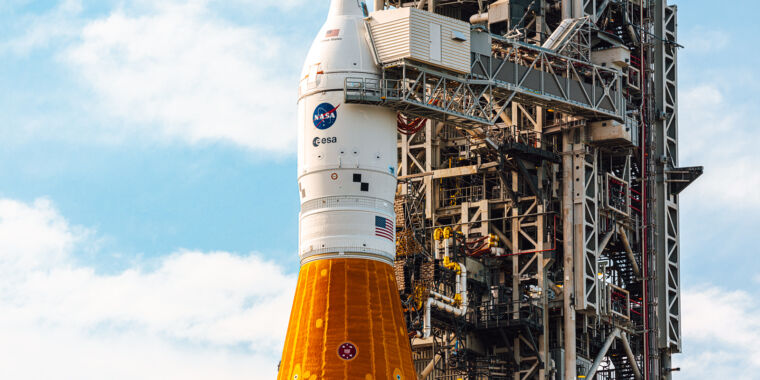
NASA, ESA, STScI, Wenlei Chen, Patrick Kelly
Over the last few decades, we’ve gotten much better at observing supernovae as they’re happening. Orbiting telescopes can now pick up the high-energy photons emitted and figure out their source, allowing other telescopes to make rapid observations. And some automated survey telescopes have imaged the same parts of the sky night after night, allowing image analysis software to recognize new sources of light.

NASA, ESA, STScI, Wenlei Chen, Patrick Kelly
But sometimes, luck still plays a role. So it is with a Hubble image from 2010, where the image happened to also capture a supernova. But, because of gravitational lensing, the single event showed up at three different locations within Hubble’s field of view. Thanks to the quirks of how this lensing works, all three of the locations captured different times after the star’s explosion, allowing researchers to piece together the time course following the supernova, even though it had been observed over a decade earlier.
I’ll need that in triplicate
The new work is based on a search of the Hubble archives for old images that happen to capture transient events: something that’s present in some images of a location but not others. In this case, the researchers were searching specifically for events that had been gravitationally lensed. These occur when a massive foreground object distorts space in a way that creates a lensing effect, bending the path of light originating behind the lens from Earth’s perspective.
Because gravitational lenses are nowhere near as carefully structured as the ones we manufacture, they’ll often create odd distortions of background objects, or in many cases magnify it in multiple locations. That’s what seems to have happened here, as there are three distinct images of a transient event within Hubble’s field of view. Other images of that region indicate that the site coincides with a galaxy; an analysis of the light from that galaxy suggests a redshift indicating that we’re looking at it as it was over 11 billion years ago.
Given its relative brightness, sudden appearance, and location within a galaxy, it’s most likely that this event is a supernova. And, at that distance, many of the high-energy photons produced in a supernova have been red-shifted down to the visible area of the spectrum, allowing them to be imaged by Hubble.
To understand more about the background supernova, the team worked out how the lens was operating. It was created by a galaxy cluster called Abell 370, and mapping the mass of that cluster allowed them to estimate the properties of the lens it created. The resulting lens model indicated that there were actually four images of the galaxy, but one wasn’t magnified enough to be visible; the three that were visible were magnified by factors of four, six, and eight.
But the model further indicated that the lensing also influenced the timing of the light’s arrival. Gravitational lenses work by forcing light to take paths between the source and observer that have different lengths. And, since light moves at a fixed speed, those different lengths mean that the light takes a different amount of time to get here. Under circumstances we’re familiar with, this ends up being an imperceptibly small difference. But on cosmic scales, it makes a dramatic difference.
Again, using the lensing model, the researchers estimated the likely delays. Compared to the earliest image, the second earliest had a delay of 2.4 days, and the third a delay of 7.7 days, with an uncertainty of about a day on all estimates. In other words, a single image of the region produced what was essentially a time course of a few days.
What was that?
By checking that Hubble data against different classes of supernovae that we’ve imaged in the modern Universe, it was likely to be produced by the explosion of either a red or blue supergiant star. And the detailed properties of the event were a much better fit to a red supergiant, one that was roughly 500 times the size of the Sun at the time of its explosion.
The intensity of the light at different wavelengths provides an indication of the explosion’s temperature. And the earliest image indicates that it was roughly 100,000 Kelvin, which suggests we were looking at it just six hours after it exploded. The latest lensed image shows that the debris had already cooled to 10,000 K over the eight days between the two different images.
Obviously, there are more recent and closer supernovae that we can study in far more detail if we want to understand the processes that drive a massive star’s explosion. If we’re able to find more of these lensed supernovae in the distant past, however, we’ll be able to infer things about the population of stars that were present much earlier in the Universe’s history. At the moment, however, this is only the second one we’ve found. The authors of the paper describing it make an effort to draw some inferences, but it’s clear those will have a higher uncertainty.
So, in a lot of ways, this doesn’t help us make major advances in understanding the Universe. But as an example of the strange consequences of the forces that govern the Universe’s behavior, it’s a pretty impressive one.
Nature, 2022. DOI: 10.1038/s41586-022-05252-5 (About DOIs).








